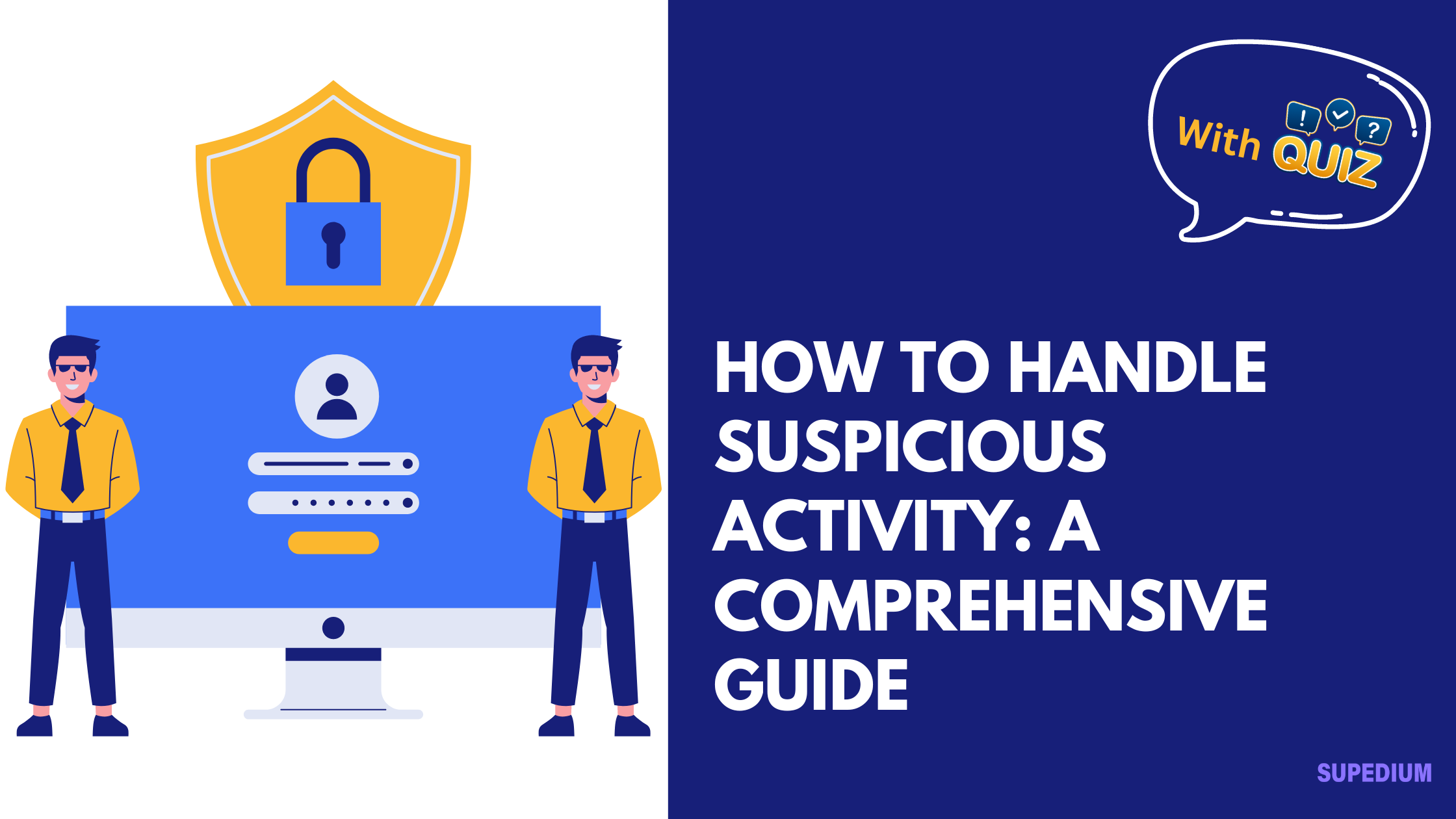Table of Contents
![]()
Suspicious activity can present serious risks, whether it’s in the workplace, community, or online. Identifying and addressing these activities effectively is crucial for maintaining safety and security. This article provides a detailed guide on how to handle suspicious activity, covering identification, reporting, response, prevention, and more.
I. Introduction
Definition of Suspicious Activity
Suspicious activity refers to behaviors or actions that deviate from expected norms and could potentially indicate security threats, fraudulent activities, or illegal actions. Such activities may involve unusual patterns of behavior, unauthorized access to information or physical spaces, and discrepancies in records.
Importance of Addressing Suspicious Activity
Addressing suspicious activity is vital to prevent potential harm or loss. Effective management ensures the safety of individuals and protects organizational assets. Whether in a corporate setting, a community environment, or an online space, timely and appropriate responses to suspicious activities can thwart threats before they escalate.
II. Identifying Suspicious Activity
Common Indicators
Recognizing suspicious activity involves observing deviations from normal behavior. Key indicators include:
- Unusual Behavior: Individuals acting out of character or engaging in activities that are atypical for their role or environment.
- Unauthorized Access: Instances where individuals gain access to restricted areas or systems without proper clearance.
- Discrepancies in Information: Inconsistencies in documentation, such as financial records or personal information, that may suggest fraudulent activity.
Contextual Factors
The context in which suspicious activity occurs can influence its interpretation:
- Environmental Factors: High-crime areas or recent incidents in the vicinity might increase the likelihood of encountering suspicious activity.
- Individual-Specific Factors: Changes in an individual’s behavior or known previous threats can be relevant in assessing suspicious activity.
III. Reporting Suspicious Activity
Internal Reporting Channels
Organizations typically have designated personnel or departments for handling suspicious activity:
- Security Team: Often responsible for on-site security and immediate response.
- Human Resources (HR): May handle internal issues related to employees, including behavior and conduct.
- Reporting Procedures: Employees should follow established procedures for documenting and reporting suspicious activity, which may include filling out forms or notifying supervisors.
External Reporting Channels
In certain situations, external reporting may be necessary:
- Law Enforcement: Contact local police or federal agencies if the activity involves potential criminal behavior.
- Specialized Agencies: For specific concerns like cyber threats or financial fraud, specialized agencies or hotlines may be appropriate.
Ensuring Anonymity and Confidentiality
To protect the identity of the reporter and handle sensitive information responsibly:
- Anonymous Reporting: Provide mechanisms for anonymous reporting to encourage vigilance without fear of retaliation.
- Confidential Handling: Ensure that information about suspicious activity is shared only with authorized personnel and handled with discretion.
IV. Responding to Suspicious Activity
Immediate Actions
Upon encountering suspicious activity, immediate actions should include:
- Assessing Risk: Evaluate the potential threat level and determine if there is an immediate danger.
- Securing the Area: If necessary, secure the location or information involved to prevent further issues.
- Precautions: Implement safety measures such as evacuations or system lockdowns, depending on the situation.
Investigation Procedures
A thorough investigation involves:
- Collecting Evidence: Gather and preserve evidence related to the suspicious activity, such as documents, digital records, or physical items.
- Coordinating with Authorities: Work with relevant law enforcement or expert agencies to investigate and address the issue.
- Documenting Actions: Keep detailed records of findings, actions taken, and communications for future reference and analysis.
Communication
Effective communication is crucial during and after the investigation:
- Informing Stakeholders: Notify relevant individuals or groups about the situation and any necessary actions they should take.
- Providing Updates: Regularly update stakeholders on the status of the investigation and any changes in the situation.
- Managing Public Relations: Handle media inquiries and public statements carefully to avoid misinformation and maintain trust.
V. Preventing Future Suspicious Activity
Security Measures
To prevent future incidents:
- Enhanced Surveillance: Implement or upgrade surveillance systems to monitor activities more effectively.
- Access Controls: Strengthen access controls to ensure that only authorized individuals can access sensitive areas or information.
- Policy Review: Regularly review and update security policies to address emerging threats and vulnerabilities.
Training and Awareness
Training programs can help individuals recognize and respond to suspicious activity:
- Education: Provide training on identifying suspicious behavior and the proper reporting procedures.
- Drills and Simulations: Conduct regular drills to prepare for potential security breaches or emergencies.
- Vigilance Culture: Encourage a culture of awareness where individuals are motivated to report concerns.
Policy and Procedure Review
Regularly reviewing and updating policies and procedures helps maintain effectiveness:
- Evaluating Protocols: Assess current response protocols and make necessary adjustments based on past incidents and new information.
- Incorporating Lessons Learned: Apply lessons from previous incidents to improve future responses.
- Ensuring Compliance: Stay up-to-date with legal and regulatory requirements related to security and reporting.
VI. Legal and Ethical Considerations
Legal Obligations
Understanding and adhering to legal requirements is essential:
- Reporting Requirements: Be aware of mandatory reporting laws that may require you to report certain types of suspicious activity.
- Privacy and Data Protection: Ensure compliance with privacy laws and regulations when handling and sharing information.
Ethical Implications
Balancing vigilance with respect for individual rights involves:
- Respecting Rights: Avoid infringing on individual rights while addressing suspicious activity.
- Fairness: Ensure that any actions taken are based on credible evidence to prevent false accusations and maintain fairness.
VII. Case Studies and Examples
Real-life Examples
Examining real-life cases can provide valuable insights:
- Successful Interventions: Review instances where timely responses prevented significant harm.
- Lessons from Failures: Analyze cases where mishandling led to negative outcomes to learn from mistakes and improve future practices.
Analysis of Outcomes
Consider the impact of handling suspicious activity on individuals and organizations:
- Impact: Assess the consequences of responses on the affected parties and overall security.
- Long-term Effects: Evaluate how incidents influenced long-term security practices and improvements.
VIII. Conclusion
Summary of Key Points
Effectively handling suspicious activity involves:
- Prompt Identification and Reporting: Recognize and report suspicious activities quickly to prevent escalation.
- Effective Response and Prevention: Implement appropriate response measures and preventive strategies to maintain security.
Final Recommendations
To enhance overall security:
- Proactive Measures: Adopt proactive security measures and stay vigilant.
- Continuous Improvement: Regularly review and improve practices based on experience and evolving threats.






Be the first to comment